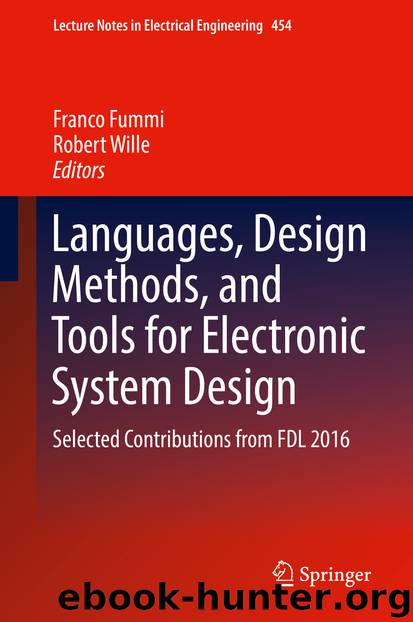Languages, Design Methods, and Tools for Electronic System Design by Franco Fummi & Robert Wille

Author:Franco Fummi & Robert Wille
Language: eng
Format: epub
Publisher: Springer International Publishing, Cham
5.3 Testbench
This section provides more details on the testbench focusing on assertion generation to guide the formal analysis. For illustration purpose, we discuss a (simplified) concrete example testbench for the IRQMP. Essentially, the input specifies incoming interrupts for the IRQMP and the output is a prioritized list of interrupt requests generated by the IRQMP.
When sending the interrupt mask 0b110 as input and injecting a fault in the RTL model that results in wrong prioritization, the output [2, 3] is observed instead of the expected output [3, 2]—since higher interrupt lines have higher priority. Based on the input and faulty output the testbench is constructed. The monitoring logic records the observed interrupts in an array irq. Furthermore, it keeps track of the number of received interrupts in the num_irqs variable. Finally, the monitor asserts that ((irq[0] ≠ 2) | | (irq[1] ≠ 3) | | (num_irqs ≠ 2)) holds at the end of simulation. Essentially, it asserts that the observed output for the TLM model is not equal to the output of the faulty RTL model. Thus, the symbolic simulation engine will search for all possible error inject locations that violate the assertion, i.e., produce the same failure at TLM as the faulty RTL model.
As an optimization, to prune irrelevant search paths which cannot produce the output of the faulty RTL model, we place assume instructions in the monitor. For this example, we would assume that the first received interrupt is 2 and the second is 3. Furthermore, we would assume that num_irqs < 2. Then a simple assert (false); can be placed at the end of simulation. Using stepwise assumptions during symbolic simulation, instead of a single assert in the end, can significantly reduce the considered search space, by pruning irrelevant search paths early.
Download
This site does not store any files on its server. We only index and link to content provided by other sites. Please contact the content providers to delete copyright contents if any and email us, we'll remove relevant links or contents immediately.
Linux Device Driver Development Cookbook by Rodolfo Giometti(3957)
Embedded Programming with Modern C++ Cookbook by Igor Viarheichyk(3785)
Implementing Cellular IoT Solutions for Digital Transformation by Dennis McCain(3704)
Embedded Linux Development Using Yocto Project - Third Edition by Otavio Salvador & Daiane Angolini(3553)
TinyML Cookbook by Gian Marco Iodice(3471)
Simplifying 3D Printing with OpenSCAD by Colin Dow(2861)
TinyML Cookbook by Gian Marco Iodice & Ronan Naughton(2623)
Fusion 360 for Makers by Lydia Sloan Cline(2231)
Networking A Beginner's Guide by Bruce Hallberg(2228)
Hands-On Linux for Architects by Denis Salamanca(2073)
But How Do It Know? by J. Clark Scott(2039)
Computers For Seniors For Dummies by Nancy C. Muir(2023)
Raspberry Pi and MQTT Essentials by Dhairya Parikh(1980)
Arduino Project Handbook, Volume 2: 25 Simple Electronics Projects for Beginners by Geddes Mark(1963)
9781803246888-ENHANCING DEEP LEARNING WITH BAYESIAN INFERENCE by Unknown(1918)
Hack and HHVM by Owen Yamauchi(1904)
31 Days Before Your CompTIA A+ Exams (Shanette Luellen's Library) by Benjamin Patrick Conry(1878)
MicroPython Projects by Jacob Beningo(1768)
Hands-On Internet of Things with MQTT by Tim Pulver(1730)
